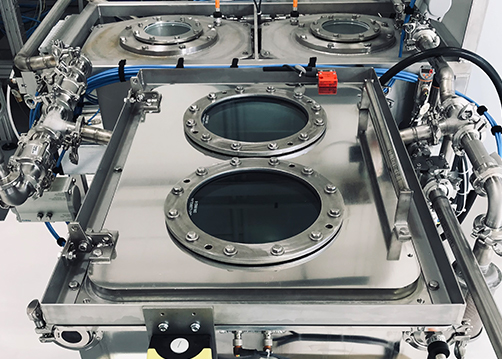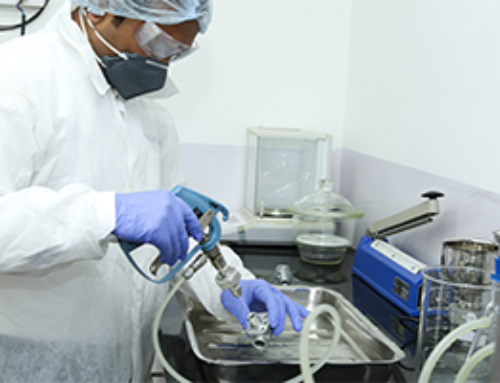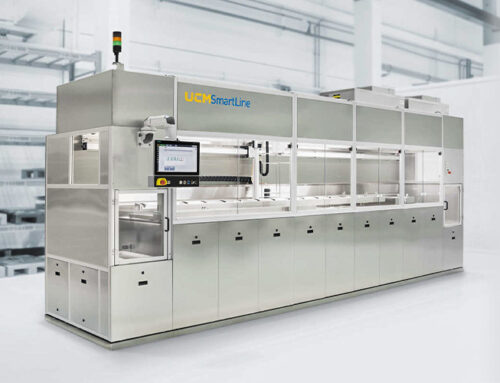
“Today, absolute cleanliness is required for many innovative processes and industries. This cannot be achieved with wet cleaning alone,” explains Norbert Rischer, Director Application. “Thanks to the great creativity, specific skills and broad knowledge of our employees in the Group, we have developed innovative cleaning processes for the highest requirements.”
EcoCcore and EcoCwave: 2 cleaning processes – 1 system
One example is our combined cleaning process, which effectively remove filmic residues – residues of processing and preservation media, release agents, silicones and other production aids or even fingerprints: While with EcoCcore a solvent-based wet cleaning is carried out first, with EcoCwave an aqueous cleaning solution is used in the beginning. In both processes, this first stage is followed by plasma cleaning for ultra-fine degreasing:
- In the first step, a wet cleaning is carried out, during which the parts are dried under vacuum.
- In the second step, plasma cleaning takes place: Here, the pressure in the working chamber is lowered to below one millibar, the process gas (e.g., filtered room air or oxygen) is introduced and the plasma is ignited. In the vacuum, the excitation of the process gas creates energy-rich ions and free electrons as well as other reactive particles that form the plasma. Contaminants such as residues of grease and oil on the component surface are chemically attacked and converted into volatile compounds.
- At the same time, the UV radiation of the plasma unfolds a cleaning effect. For example, long-chain hydrocarbon compounds are broken. The gaseous degradation products of the plasma cleaning process are extracted from the working chamber.
EcoCcore and EcoCwave: The fast, effective and economical way to filmic cleanliness
Norbert Rischer, Director Application explains: “By combining classic wet cleaning with modern plasma treatment, we made completely new material combinations and processes possible with EcoCcore and EcoCwave. And our system offers manufacturers many more advantages: high flexibility of the system in use, reduced process times, low investment and operating costs and a small ecological footprint.”
PPC – Pulsated Pressure Cleaning: new cleanliness requirements demand integrated solutions
Another development of the SBS Ecoclean Group is PPC – Pulsated Pressure Cleaning: When cleaning complex component geometries, for example 3D-printed bodies, with capillary structures, hollow bodies or different materials, ultrasonic cleaning reaches its limits. In order to meet the ever-increasing cleaning requirements in medical technology, the high-purity industry and optics, the PPC was developed in teamwork between our competence centres in Filderstadt and Monschau: Filderstadt focused on aqueous and solvent chamber systems to optimise the process and Monschau on CLP immersion systems .

PPC – Pulsated Pressure Cleaning: Two modes of action for significantly improved component cleaning
In both types of system, a component to be cleaned is placed in a process chamber filled with a liquid medium and tightly sealed. The PPC process now generates two different modes of action to clean the components significantly better:

- The air remaining in the chamber is evacuated, creating a negative pressure. This causes the air in the component to expand. If the chamber is now ventilated, the air in the component contracts again and sucks medium into the component (e.g. capillary structures). This process is repeated cyclically so that these critical areas are cleaned and rinsed where otherwise no liquid medium can reach.
- Another cleaning effect is created by lowering the pressure in the working chamber until steam bubbles form. This boiling process is abruptly stopped by a rapid increase in pressure – up to above the steam pressure. The steam bubbles collapse. When the bubbles form on the surface of the component, the medium is displaced; when the bubble collapses, medium flows to these points and detaches contaminants. This bubble formation also takes place in concealed and shadowed areas, e.g. cavities, boreholes.
With the help of the innovative PPC process, the cycle times for a pressure change can be reduced by 50 %. This enables our customers to meet previously unattainable purity requirements.
Marko Flatten, Product Development Manager comments: “Together in our knowledge network, the SBS Ecoclean Group can develop integrated solutions that meet the new standards of cleanliness. To achieve this, we bring together the creativity, knowledge and unique expertise of our specialists every day.”







